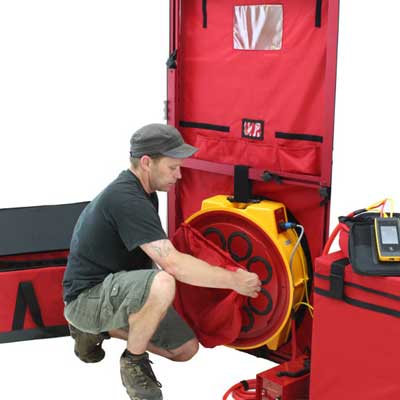Air Permeability vs Background Ventilation – What’s the difference?
Since the introduction of the Background Ventilation Testing (BVT) methodology for retrofit purposes, we have seen an increase in confusion around what it is and how it differs from the long standing methodology of Air Pressure Testing (APT).
Elmhurst are here to set the record straight and provide clarity on what the methodologies are and their uses, the differences between them, and how these competencies could benefit your energy assessment advice.
What is Air Pressure Testing?
Air pressure testing, also referred to as air permeability testing, airtightness testing or air leakage testing, is the methodology used the identify the amount of air that escapes unintentionally from a building through gaps and air leakage paths such as under skirting boards or behind bath panels. This methodology excludes any air leakage through controlled ventilation systems such as extract fans.
First introduced in 2002, this methodology is used within building regulations for both residential and commercial buildings which set a maximum limit for air leakage for each type of building. Air pressure testing has also been implemented in the retrofit process as part of PAS 2035 Risk Pathway C (applicable to large scale, high risk, retrofit projects such as a block of apartments) and follows the same methodology.
The unintentional loss of air from a building can lead to an increase in the occupant’s energy bills and the building’s carbon emissions. Due to the cycle of convection, when you lose the warm air from within a building it is replaced by cooler, external air that needs to be heated to bring the building back up to temperature. The air pressure testing methodology quantifies this air loss in to an “Air Permeability Score”. The higher the air permeability score, the more air the building is unintentionally losing.
What is the methodology for Air Pressure Testing?
The test standard followed for both compliance and retrofit for pressure testing is the CIBSE TM23 standard. Both the Blower Door test method and the Pulse test method are acceptable under the TM23 standard and Building Regulations. Before the test commences, the building is prepared by closing all trickle vents and temporarily sealing extract fans and through wall vents. Sealing of these vents is essential because the main objective of air pressure testing is to check for unintentional air leakage.
The results of an air pressure test are expressed as an air permeability score where the higher the score, the more air the building is unintentionally losing
Air Pressure Testing in Existing Dwellings
The Building Research Establishment (BRE) on Behalf of the Government Department for Energy Security and Net Zero (DESNZ) have confirmed that RdSAP 10 will include the option to enter an air pressure test result. Where an air pressure test has been conducted on an existing dwelling, a Domestic Energy Assessor will be able to override the default result within the assessment to give a more accurate representation of the properties energy performance.

What is Background Ventilation Testing?
Background ventilation testing was introduced to the industry through retrofit. There was a need to prove that dwellings subject to retrofit improvements under PAS 2035 had adequate ventilation within the existing systems that the requirements for additional ventilation could be bypassed. This was given the term ‘background ventilation’ as it referred to ventilation happening in the background of the building in its current state and measures the air change rate. Ventilation is crucial for retrofit projects as improvements to the dwelling can decrease the air exchange rate which in turn can increase the risk of damp and mould. Air exchange rate or the number of ‘Air changes’ is the amount of air that is circulated in the property and replaced with fresh air which prevents moisture and pollution build up in the dwelling.
What is the methodology for Background Ventilation Testing?
The test method for background ventilations is The Installation Assurance Authority (IAA) guidance. The test method requires that whole house and bedrooms tests are carried out. Preparing the property for the test includes closing trickle vents and turning off or closing any other vents or ventilation systems but not sealing them, as you would in an air pressure test. This gives an indication of the buildings worst case background ventilation. The test can be conducted by using Pulse or Blower Door test equipment, however the test does lend itself to the Pulse equipment which allows for the testing of the door undercuts in bedroom tests where a blower door would need to be installed.
Background Ventilation in measured in Air Change Rate (ACH) which is defined as the number of times the entire volume of the space (dwelling/room) is replaced. A rate of 1 means that all the air inside the building is exchanged with the air from outside the building, once every hour.
Any work undertaken within the Trustmark guidance requires the tester to also be a member of the IAA and accredited to a competent person scheme such as the Elmhurst Airtightness Scheme.

Air Tightness Testing Training
The updates to Part L England (2021), Part L Wales (2022) and Section 6 Scotland (2022) have all implemented mandatory air testing in new build homes. This means all new build homes that fall under these regulations require an air pressure test, when previously there were some exemptions.. This has also been proposed in a recent consultation for changes to Building Regulations in Northern Ireland expected in 2024.
As a result, it is likely that demand for air tests will increase meaning it’s the perfect time to become qualified in air pressure testing.
Interested? Elmhurst’s Level 1 air pressure testing course is suitable for new entrants who want to upskill to a qualified airtightness tester
Find out more >
Background Ventilation Testing Training
We have seen a continued increase in the number of background ventilation tests submitted through the Elmhurst Airtightness Scheme with no signs of this slowing down. The changes to PAS 2035 requirements will continue to use the Background Ventilation method and many more will see the benefit of the less intrusive tests.
Expand your skillset with Elmhurst’s Background Ventilation training.
